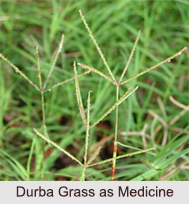 Cynodon dactylon is a sturdy grass that is found in warm climates and grows best in sandy soil or clay. It is popularly known as Durba Grass which is a popular natural aid for better health. This elegant and most valuable grass like many other useful vegetables has a niche in the temple of the Hindu religion.
Cynodon dactylon is a sturdy grass that is found in warm climates and grows best in sandy soil or clay. It is popularly known as Durba Grass which is a popular natural aid for better health. This elegant and most valuable grass like many other useful vegetables has a niche in the temple of the Hindu religion.
Benefits of Durba Grass
Medicinally, the fresh juice of the leaves is considered astringent, and is used as a snuff in Epistaxis. The bruised grass is a popular application to bleeding wounds.
This article is a stub. You can enrich by adding more information to it. Send your Write Up to content@indianetzone.com




















